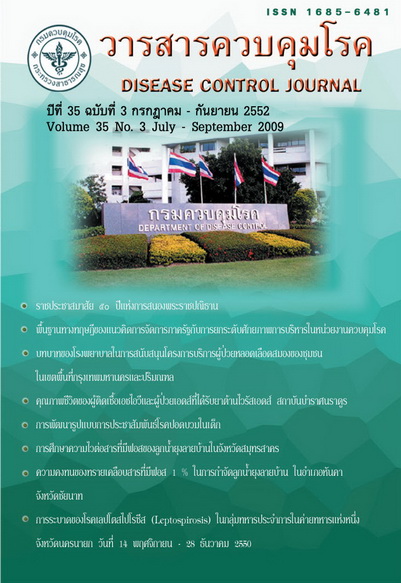Development of a Model for Public Information and Education on Prevention and Control of Childhood Pneumonia
Keywords:
Public information and education, radio presenters/announcers, childhood pneumoniaAbstract
Pneumonia was a public health problem and often found among children under 5 years old. Based on some community surveys, the level of knowledge and behavior on disease prevention and child care among parents and caretakers of children was lower than the target level. In addition, use of antibiotics without prescription was still high. This project therefore developed a model package of media for public information and education through radio broadcast so that radio stations and presenters/announcers could use the package to inform and educate parents, caretakers of children and the public. The model package was called, "Media package for radio broadcast on childhood pneumonia." It consisted of radio spots, radio documentaries and knowledge programs. The Media package was pre-tested in Bangkok and 3 provinces before use. It was broadcasted on the National Children Day and during the months of the disease high prevalence. An evaluation was conducted among radio presenters/announcers. It was found that majority of the radio presenters/announcers (98.2 percent) broadcasted the subject using the Media package during July-September and 98.2 percent were satisfied with the Media package. The evaluation conducted among radio audience who were parents, caretakers of children and the public finding that 94.7 percent of them knew of childhood pneumonia, 68.5 percent of the radio audience heard it from radio, 100 percent of the audience said they would take the children who they thought had pneumonia to see a doctor or to a clinic or a hospital and 98.9 percent of those who know of pneumonia would share knowledge on pneumonia with their family members or neighbors. In conclusion, it was found that the radio media network was interested and supportive and used the media package to provide public information and education which resulted in awareness, knowledge and appropriate behavior among parents, caretakers of children and the public concerning childhood pneumonia. Therefore, this project should be expanded and sustained. In the following years, for example, the project should cover networks of community radios throughout the country in addition to other networks that could advocate and help scaling up public information and education on prevention and control of childhood pneumonia such as youth networks, NGO networks, education institutions, housewives clubs, elderly clubs and mass media networks. Finally, possibility should be explored to integrate prevention and control of childhood pneumonia with the prevention and control efforts of other diseases that often spread during the same period of the year.
Downloads
References
2. สำนักระบาดวิทยา กรมควบคุมโรค. สรุปรายงานการเฝ้าระวังโรค 2550. กรุงเทพมหานคร: โรงพิมพ์องค์การรับส่งสินค้าและพัสดุภัณฑ์, 2550.
3. สำนักโรคติดต่อทั่วไป กรมควบคุมโรค. การประเมินผลการป้องกันควบคุมโรคติดเชื้อเฉียบพลันระบบหายใจและโรคอุจจาระร่วงในเด็กอายุต่ำกว่า 5 ปี ในชุมชนปี 2548. กรุงเทพมหานคร: สำนักงานพระพุทธศาสนาแห่งชาติ.
4. สำนักงานเผยแพร่และประชาสัมพันธ์ กรมควบคุมโรค. การศึกษาการรับรู้ข้อมูลข่าวสารเรื่องโรคและภัยสุขภาพของประชาชนปี 2549. เอกสารอัดสำเนา. 2549.
Downloads
Published
How to Cite
Issue
Section
License
Articles published in the Disease Control Journal are considered as academic work, research or analysis of the personal opinion of the authors, not the opinion of the Thailand Department of Disease Control or editorial team. The authors must be responsible for their articles.


.png)



